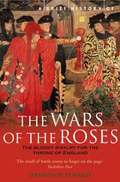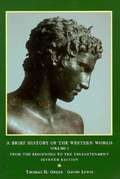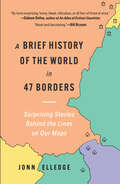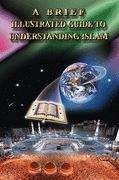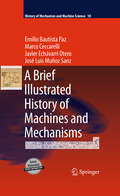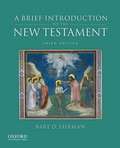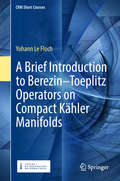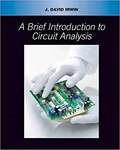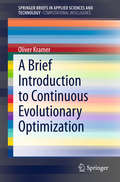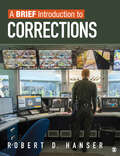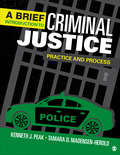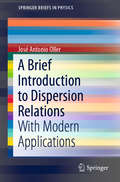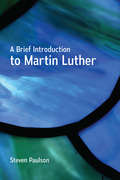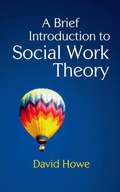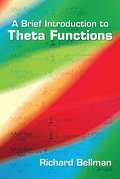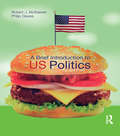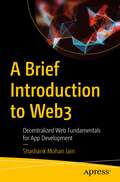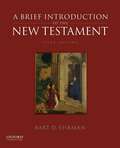- Table View
- List View
A Brief History of the Wars of the Roses (Brief Histories)
by Mr Desmond SewardDuring the fifteenth century England was split in a bloody conflict between the Houses of York and Lancaster over who should claim the crown. The civil wars consumed the whole nation in a series of battles that eventually saw the Tudor dynasty take power. In A Brief History of the Wars of the Roses, Desmond Seward tells the story of this complex and dangerous period of history through the lives of five men and women who experienced the conflict first hand. In a gripping narrative the personal trials of the principal characters interweave with the major events and personalities of one of the most significant turning points in British history.
A Brief History of the Western World, Volume I: From the Beginning to the Enlightenment (7th edition)
by Thomas H. Greer Gavin LewisThis book contains a comprehensive view of the development of Western civilization. Each chapter provides broad coverage of political, social, cultural, and religious themes from different time periods.
A Brief History of the Western World, Volume II: From the Late Middle Ages to the Present (8th edition)
by Thomas H. Greer Gavin LewisThis book contains a comprehensive view of the development of Western civilization. Each chapter provides broad coverage of political, social, cultural, and religious themes from different time periods.
A Brief History of the World in 47 Borders: Surprising Stories Behind the Lines on Our Maps
by Jonn Elledge#1 International Bestseller Every border tells a surprising story in this uncommonly enlightening history that will change the way you understand the world “A novel and fascinating perspective on world history.”—Bill Bryson, author of A Short History of Nearly Everything Many lines on the map are worth far more than a thousand words, going well beyond merely marking divisions between nations. In this eye-opening investigation into the most remarkable points on the map, a single boundary might, upon closer inspection, reveal eons of history—from epic tales of conquest, treaties, and alliances to intimate, all-too-human stories of love, greed, and folly. Sometimes rooted in physical geography, sometimes entirely arbitrary, none of the lines we know today were inevitable, and all might have looked quite different if not for the intricate interplay of chance and ambition. By listening to the stories these borders have to tell, we can learn how political identities are shaped, why the world’s boundaries look the way they do—and what they tell us about our world and ourselves. From the very first maps in Egypt to the Roman attempts to define the boundaries of civilization, from the profound shift in meaning of the Mason–Dixon line to the secret British-French agreement to carve up the Ottoman Empire during the First World War, and from the dark consequences of Detroit’s city limits to the intriguing reason why landlocked Bolivia still maintains a navy, this is a singular look at human history—told through its most spellbinding border stories.
A Brief Illustrated Guide to Understanding Islam (2nd edition)
by I. A. IbrahimThis book is a brief guide to understanding Islam. God has supported His last Prophet Muhammad with many miracles and much evidence which proves that he is a true Prophet sent by God. Also, God has supported His last revealed book, the Holy Qur'an, with many miracles that prove that this Qur'an is the literal word of God, revealed by Him, and that it was not authored by any human being.
A Brief Illustrated History of Machines and Mechanisms (History of Mechanism and Machine Science #10)
by Marco Ceccarelli Emilio Bautista Paz Javier Echávarri Otero José Luis Muñoz SanzThis work deals with mechanical manufacturing processes in history, examined through the machines associated with those processes. A tool is only included if it is part of a machine tool, with devices made up of moving parts. Once the analytical field has been marked out, the chosen descriptive method is basically graphic. This historical compendium attempts to give a wide-angle view of historical development without making an in-depth analysis of each of the examples presented. Moreover, this book illustrates the historical development of machines and mechanisms more from a technical point of view rather than a strictly history of science point of view since the authors are mechanical engineers who are interested and motivated to examine the most significant facts in their own area of knowledge of the Theory of Machines and Mechanisms. A full understanding of the historical development of Technology also needs the help of experts in technical matters who can appreciate and reassess bygone achievements in the light of their own technical knowledge. More collaboration between science historians and technical experts is needed, as is currently the case in the field of Industrial Archaeology. Thus, this book is also an attempt to set out a technical approach to the historical development of machines and mechanisms, but without too many technical details that will prevent its understanding being purely historical. At the beginning of each chapter there is a global reference to the period embraced, the most relevant facts, and the most significant treatises in the context of machine history. Following this introduction each chapter contains a series of sections on the types of machines that are representative of the period analysed together with illustrations to accompany the text. A fairly extensive bibliography enables the reader to make a deeper historical analysis.
A Brief Introduction To Hinduism: Religion, Philosophy, And Ways Of Liberation
by A. L. Herman“I have read Arthur Herman’s Introduction to Hinduism with considerable interest and pleasure. It is bold and innovative, clearly written, well organized, and quite provocative.” —Eliot Deutsch University of Ha wail at Manoa
A Brief Introduction To Social Role Valorization
by Wolf WolfensbergerSRV Theory opens up to students a different way of understanding the world in general, and the experiences of human suffering and marginalization in particular.
A Brief Introduction To The New Testament
by Bart D. EhrmanFeaturing vibrant full color throughout, this new edition of A Brief Introduction to the New Testament is a concise version of Bart D. Ehrman's best-selling The New Testament: A Historical Introduction to the Early Christian Writings, Fourth Edition. Retaining the approach of the longer textbook while condensing and simplifying much of its material, this volume looks at the New Testament from a consistently historical and comparative perspective and emphasizes the rich diversity of the earliest Christian literature. Distinctive to this study is its emphasis on the historical, literary, and religious milieux of the Greco-Roman world, including early Judaism. A Brief Introduction to the New Testament, Second Edition, incorporates a wealth of pedagogical resources including an extensive text box program, study questions, maps, timelines, and more than seventy photos (including two photo essays). A comprehensive glossary contains more than 200 key terms; these terms appear in boldface type the first time they are used in each chapter and are also listed at the end of each chapter in which they appear. An updated Student Website contains chapter summaries, key terms, guides for reading, and self-quizzes. An accompanying Instructor's Manual provides chapter summaries, pedagogical suggestions, and a test bank.
A Brief Introduction to A Philosophy of Music and Music Education as Social Praxis
by Thomas A. RegelskiMusic and Music Education as Social Praxis is a brief introduction to a praxial theory of music education, defined by author. It is grounded in an interdisciplinary approach, for undergraduate and graduate students in music education. Drawing upon scholarship from a range of disciplines, including philosophy and sociology, the book emphasizes and highlights thinking of music as an active social practice and offers an alternative to existing approaches to music education. This text advocates for an alternative approach to teaching music, rooted in the social practice of music, and will supplement Foundations or Methods courses in the Music Education curriculum.
A Brief Introduction to Berezin–Toeplitz Operators on Compact Kähler Manifolds (CRM Short Courses)
by Yohann Le FlochThis text provides a comprehensive introduction to Berezin–Toeplitz operators on compact Kähler manifolds. The heart of the book is devoted to a proof of the main properties of these operators which have been playing a significant role in various areas of mathematics such as complex geometry, topological quantum field theory, integrable systems, and the study of links between symplectic topology and quantum mechanics. The book is carefully designed to supply graduate students with a unique accessibility to the subject. The first part contains a review of relevant material from complex geometry. Examples are presented with explicit detail and computation; prerequisites have been kept to a minimum. Readers are encouraged to enhance their understanding of the material by working through the many straightforward exercises.
A Brief Introduction to Circuit Analysis
by J. David IrwinA Brief Introduction to Circuit Analysis.
A Brief Introduction to Continuous Evolutionary Optimization (SpringerBriefs in Applied Sciences and Technology)
by Oliver KramerPractical optimization problems are often hard to solve, in particular when they are black boxes and no further information about the problem is available except via function evaluations. This work introduces a collection of heuristics and algorithms for black box optimization with evolutionary algorithms in continuous solution spaces. The book gives an introduction to evolution strategies and parameter control. Heuristic extensions are presented that allow optimization in constrained, multimodal and multi-objective solution spaces. An adaptive penalty function is introduced for constrained optimization. Meta-models reduce the number of fitness and constraint function calls in expensive optimization problems. The hybridization of evolution strategies with local search allows fast optimization in solution spaces with many local optima. A selection operator based on reference lines in objective space is introduced to optimize multiple conflictive objectives. Evolutionary search is employed for learning kernel parameters of the Nadaraya-Watson estimator and a swarm-based iterative approach is presented for optimizing latent points in dimensionality reduction problems. Experiments on typical benchmark problems as well as numerous figures and diagrams illustrate the behavior of the introduced concepts and methods.
A Brief Introduction to Corrections
by Robert D. HanserA Brief Introduction to Corrections is a condensed version of the best-selling Introduction to Corrections by Robert D. Hanser. This new text provides students with an overview of corrections that is both practitioner-driven and grounded in modern research. Experienced correctional practitioner and scholar Robert D. Hanser shows readers how the corrections system actually works, from classification to security and treatment to demonstrating how and why correctional practices are implemented.
A Brief Introduction to Corrections
by Robert D. HanserA Brief Introduction to Corrections is a condensed version of the best-selling Introduction to Corrections by Robert D. Hanser. This new text provides students with an overview of corrections that is both practitioner-driven and grounded in modern research. Experienced correctional practitioner and scholar Robert D. Hanser shows readers how the corrections system actually works, from classification to security and treatment to demonstrating how and why correctional practices are implemented.
A Brief Introduction to Criminal Justice: Practice and Process
by Dr. Kenneth J. Peak Tamara D. Madensen-HeroldA Brief Introduction to Criminal Justice: Practice and Process is a condensed version of the best-selling Introduction to Criminal Justice: Practice and Process by Kenneth J. Peak and Tamara D. Madensen-Herold. This new text uses a practical, applied approach to teach students the foundations of the U.S. criminal justice system in a concise and accessible format. The authors draw on their many years of combined practitioner and academic experience to explain the importance of criminal justice and show how key trends, emerging issues, and practical lessons can be applied in the field. INSTRUCTORS: A Brief Introduction to Criminal Justice: Practice and Process is accompanied by a complete teaching and learning package! Contact your rep to request a demo. SAGE vantage Digital Option SAGE vantage is an intuitive digital platform that delivers this text&’s content in a learning experience carefully designed to ignite student engagement and drive critical thinking. Built with you and your students in mind, it offers easy course set-up and enables students to better prepare for class. Contact your rep to learn more. SAGE Premium Video SAGE Premium Video includes original Student on the Street videos and Criminal Justice in Practice videos that boost comprehension and bolster analysis. Watch a sample SAGE coursepacks Intuitive and simple to use, SAGE coursepacks makes it easy to import our quality instructor and student resource content into your school&’s learning management system (LMS). SAGE edge This companion website offers students a robust online environment with an impressive array of teaching and learning resources.
A Brief Introduction to Criminal Justice: Practice and Process
by Dr. Kenneth J. Peak Tamara D. Madensen-HeroldA Brief Introduction to Criminal Justice: Practice and Process is a condensed version of the best-selling Introduction to Criminal Justice: Practice and Process by Kenneth J. Peak and Tamara D. Madensen-Herold. This new text uses a practical, applied approach to teach students the foundations of the U.S. criminal justice system in a concise and accessible format. The authors draw on their many years of combined practitioner and academic experience to explain the importance of criminal justice and show how key trends, emerging issues, and practical lessons can be applied in the field. INSTRUCTORS: A Brief Introduction to Criminal Justice: Practice and Process is accompanied by a complete teaching and learning package! Contact your rep to request a demo. SAGE vantage Digital Option SAGE vantage is an intuitive digital platform that delivers this text&’s content in a learning experience carefully designed to ignite student engagement and drive critical thinking. Built with you and your students in mind, it offers easy course set-up and enables students to better prepare for class. Contact your rep to learn more. SAGE Premium Video SAGE Premium Video includes original Student on the Street videos and Criminal Justice in Practice videos that boost comprehension and bolster analysis. Watch a sample SAGE coursepacks Intuitive and simple to use, SAGE coursepacks makes it easy to import our quality instructor and student resource content into your school&’s learning management system (LMS). SAGE edge This companion website offers students a robust online environment with an impressive array of teaching and learning resources.
A Brief Introduction to Dispersion Relations: With Modern Applications (SpringerBriefs in Physics)
by José Antonio OllerThis text offers a brief introduction to the dispersion relations as an approach to calculate S-matrix elements, a formalism that allows one to take advantage of the analytical structure of scattering amplitudes following the basic principles of unitarity and causality.First, the case of two-body scattering is considered and then its contribution to other processes through final-state interactions is discussed. For two-body scattering amplitudes, the general expression for a partial-wave amplitude is derived in the approximation where the crossed channel dynamics is neglected. This is taken as the starting point for many interesting nonperturbative applications, both in the light and heavy quark sector. Subsequently crossed channel dynamics is introduced within the equations for calculating the partial-wave amplitudes. Some applications based on methods that treat crossed-channel dynamics perturbatively are discussed too.The last part of this introductory treatment is dedicated to the further impact of scattering amplitudes on a variety of processes through final-state interactions. Several possible approaches are discussed such as the Muskhelishvili-Omnes dispersive integral equations and other closed formulae. These different formalisms are then applied in particular to the study of resonances presenting a number of challenging properties. The book ends with a chapter illustrating the use of dispersion relations in the nuclear medium for the evaluation of the energy density in nuclear matter.
A Brief Introduction to John Calvin
by Christopher ElwoodHonoring the 500th anniversary of the Reformation, Christopher Elwood offers an insightful and accessible overview of John Calvin's theological ideas within their historical context. A Brief Introduction to John Calvin discusses the trials and tribulations Calvin encountered as he ministered and taught in Geneva, paying special attention to the theological controversies associated with the Trinity and predestination. In this concise introduction, Elwood explores the development of Calvinism and its influence in today's world.
A Brief Introduction to Martin Luther
by Steven PaulsonIn the sixteenth century, Martin Luther started a reformation movement that revolutionized Europe and the history of the Christian faith. His far-reaching reforms of theological understanding and church practices dramatically changed both church and society in Europe and beyond. In honor of the 500th anniversary of the Reformation, Steven Paulson provides an engaging, concise introduction to Martin Luther's life and the major themes in his theology.
A Brief Introduction to Social Work Theory
by David HoweThis crisp text, by one of social works most highly regarded commentators, offers the perfect entry point into the complex world of social work theory. Written in a clear conversational style and organized into short, clearly labelled chapters, students and practitioners will find this an invaluable point of refreshment and reference.
A Brief Introduction to Theta Functions (Dover Books on Mathematics)
by Richard BellmanBrief but intriguing, this monograph on the theory of elliptic functions was written by one of America's most prominent and widely read mathematicians. Richard Bellman encompasses a wealth of material in a succession of short chapters, spotlighting high points of the fundamental regions of elliptic functions and illustrating powerful and versatile analytic methods. Suitable for advanced undergraduates and graduate students in mathematics, this introductory treatment is largely self-contained. Topics include Fourier series, sufficient conditions, the Laplace transform, results of Doetsch and Kober-Erdelyi, Gaussian sums, and Euler's formulas and functional equations. Additional subjects include partial fractions, mock theta functions, Hermite's method, convergence proof, elementary functional relations, multidimensional Poisson summation formula, the modular transformation, and many other areas.
A Brief Introduction to US Politics
by Robert J. MckeeverA Brief Introduction to American Politicsprovides a coherent and succinct account of how contemporary American politics blends enduring principles with the realities and demands of the present day. Beginning with a brief overview of American society today, the book introduces the constitutional framework of American politics and the fluid concept and practice of federalism. It also covers the major features of the representative process, looking at both elections and main players such as parties, interest groups, and the media. Chapters on the major institutions of the federal government - the presidency, the Congress, and the Supreme Court – examines how they are simultaneously independent and constrained by each other. Chapters on domestic and foreign policy demonstrate how government and politics work in connection with the system’s main outputs. A Brief Introduction to American Politicsis a shorter version of Politics USA and is intended for students who need an introduction to the essential features of the American political system.
A Brief Introduction to Web3: Decentralized Web Fundamentals for App Development
by Shashank Mohan JainJourney into the world of Web3-based application development, its related protocols, and its usage in developing decentralized applications. This book will explain how programmable blockchains are revolutionizing the world of web applications, which can be run on decentralized platforms or peer-to-peer networks like IPFS.You'll start with an introduction to decentralization with a focus on blockchain implementations like Ethereum and Bitcoin. You'll then learn to develop simple decentralized applications (dApps) using Solidity, the language used for developing apps with Ethereum as well as smart contracts, wallets, gateways and NFTs. This book also covers how security and scale are addressed by L2 networks for scaling Bitcoin and Ethereum blockchains. A Brief Introduction to Web3 is your go-to guide for setting up simple Web3 applications using the Ethereum blockchain programming model.What You Will Learn Build NFT tokensExamine Web3 differs from Web2-based applicationsUnderstand the fundamentals of blockchain and the corresponding data structures around itSee how consensus and trustless computing can be performed using blockchain Use Solidity and Truffle to build Web3 applications Who This Book Is For Software developers and architects who are looking to hone their skills in dApps and web3 applications developed on sound principles of decentralized computing.
A Brief Introduction to the New Testament
by Bart D. EhrmanA Brief Introduction to the New Testament, Fifth Edition, is a concise version of Bart D. Ehrman's best-selling The New Testament: A Historical Introduction to the Early Christian Writings, Seventh Edition. Retaining the approach of the longer textbook while condensing and simplifying much of its material, this volume looks at the New Testament from a consistently historical and comparative perspective and emphasizes the rich diversity of the earliest Christian literature. Distinctive to this study is its emphasis on the historical, literary, and religious milieux of the Greco-Roman world, including early Judaism.
